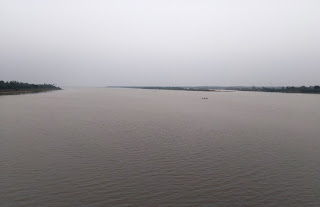THE HISTORICAL RUINED FORT (POTAGARH) IN SOUTH ODISHA, INDIA
Potagarh Fort ::- The Fort Is Located Near The Town Of Ganjam In South Odisha. The Fort Is Located On The Banks Of Rushikulya River, Just A Little Upstream From Where It Meets The Sea. The Name Is Because The Fort Is Partly Sunk And Not Easily Visible From A Distance. Its Lilliputian Height Camouflages It, The Entrance Gate Which Is Within The Folds Of Rampart Can Be Seen Only At Close Quarters.
Potagarh Is One Of The Forgotten Vestiges Of The Colonials Maritime History Of Odisha And Stands As A Mute Witness To The Vicissitudes Of Time. Its Antiquity Is Shrouded In Mystery, But It Must Have Originally Been A Flourishing Ancient Port, Which Was Later Taken Over By The Muslim Traders During Mughal Rule. The Maritime History Of Odisha Reveals That The Danes And Portuguese Too Had Control Over The Port For Some Time Before It Was Taken Over By The French In 1757 AD. The Estuary Made The River Deep And Navigable For Ships To Sail Some Distance Inland.
This Fort Is Not Standalone One. Rather It Is A Part Of Small Cluster Of Forts Built Over Time By Successive Rules. There Is Conclusive Evidence That It Was An Ancient Port And The Earliest Record Dates To The 17th Century. The Mughal Origin Is Evidence Form The Old Mosque In The Vicinity In 1753, The Northern Circes Were Ceded To The French And Monsieur De Bussy, The French Commander, Took Control Over Ganjam And Functioned From Potagarh. He Undertook Renovation And Fortified The Fort From All Sides. The French Ships Docked Quite Often At The Port And There Was A Thriving French Settlement In The Fort. The Fort Was Safe Anchorage For Ships, And Many Trading Vessels Were Called There. There Was A Thriving Ship-Repair Industry Too.
The Port Was Famous For The Export Of Rice, Beeswax, Iron, Cloth, Forest Produce Like Stick Lac And Timber To Madras And Other Region Of The Coromandel Coast. The Local Silk And Cotton Clothes Were Also Traded From This Port. Even Trading In Slaves Has Been Reported From Here. During The French Occupation Period, Only Christians Were Allowed Inside The Fort, The Natives Resided Outside In The Nearby Villages Of Ganjam And Chatrapur. The French Ultimately Subjugated These Areas And Fixed Tributes From The Feudal Chiefs. Today, The Only Evidence Of The French Presence Is Two Tombs In The Near By Cemetery. In 1765, The Northern Circes Were Granted To The English By An Imperial Farman. French Domination Ended And Edward Cotsford Was Appointed The British Resident Of Ganjam In 1766. Cotsford Constructed Some More Buildings Inside The Fort, Which Besides Residences, Had Office Buildings, Magazines For The Artillery, An Armoury, Store, Custom Houses, Granaries And Water Tanks.












0 Comments